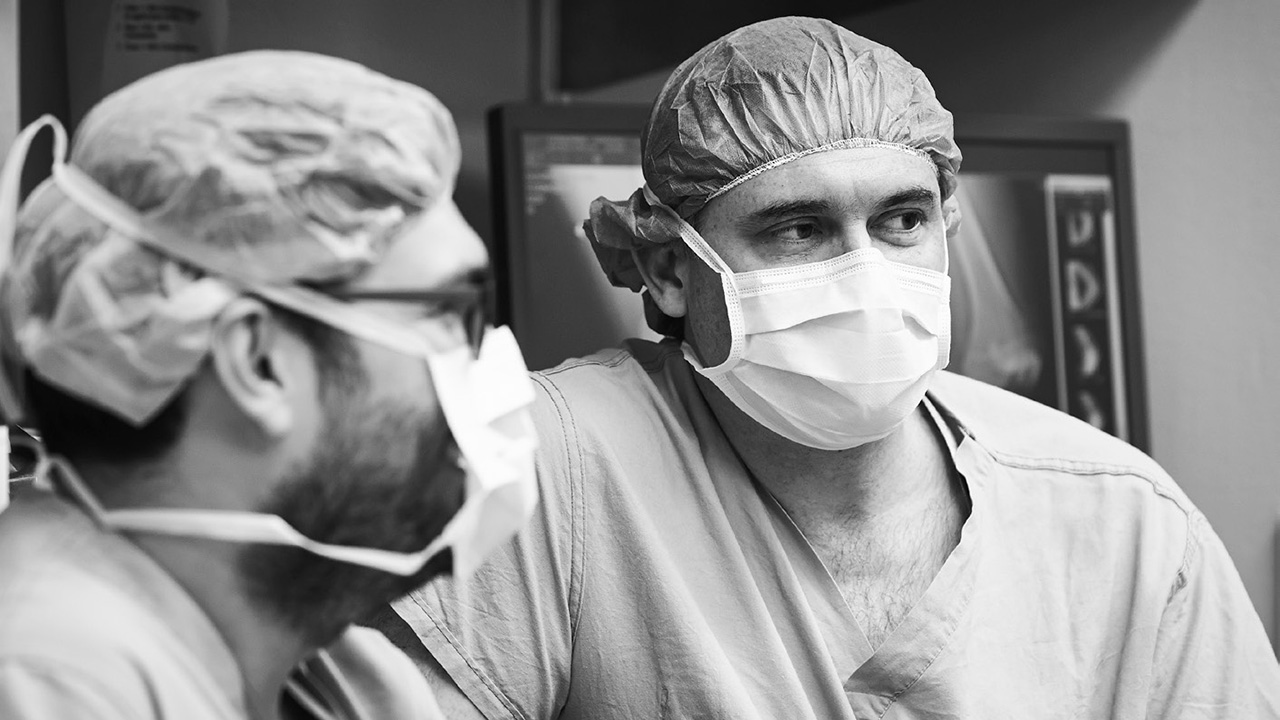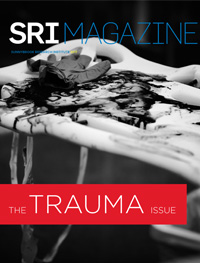Putting Humpty back together

Orthopaedic trauma surgeons repair badly broken bodies and are changing practice through their work
June 12, 2017

Dr. Richard Jenkinson (right), head of orthopaedic trauma at Sunnybrook, is studying whether surgical stabilization of rib fractures improves people's ability to breathe on their own.
Some people thrive on routine, so much so that they seek jobs where they do the same work, day in and day out. Dr. Richard Jenkinson is not one of those people. A researcher in the Holland Bone and Joint Research Program at Sunnybrook Research Institute (SRI) and the head of orthopaedic trauma at Sunnybrook, Jenkinson says he enjoys being challenged by the unexpected. “I like the variety,” he says. “Almost everybody has a slightly different version of the same kind of fractures. I like putting pieces of the ‘puzzle’ together.”
As part of the trauma care team at Sunnybrook, which has the largest regional trauma centre in Canada, Jenkinson looks after people who have fractures of the pelvis, hip, leg, or arm. These injuries are usually due to motor vehicle crashes or falls from heights, and can be in addition to grave conditions like punctured organs and internal bleeding. He, along with colleagues from six centres across Canada, is conducting a randomized controlled trial comparing approaches to managing a chest wall injury called flail chest. This occurs when a section of ribs is broken in multiple places and doesn’t move in synch with the rest of the rib cage. “Instead of expanding as it’s supposed to, to help pull air into the chest, that segment will sink in, which is very painful because it’s moving broken bones inappropriately,” says Jenkinson. He notes that about a handful of patients with flail chest are admitted to Sunnybrook every month.
The way physicians tend to rib fractures varies widely, from surgery to stabilize the ribs so that the chest wall moves as a unit, to, well, nothing. “In the past, rib fractures were one of those things where we’d say, ‘there’s nothing much we can do. The rib fractures will heal on their own,’” says Dr. Hans Kreder, an orthopaedic trauma surgeon and a scientist in the Holland Bone and Joint Research Program at SRI. He is a co-investigator on the flail chest trial, which will compare these two approaches. Kreder notes that in letting fractures heal naturally, which some doctors are wont to do, sometimes the pain is so great that people cannot breathe properly, and therefore are put on ventilators. This solution is far from ideal, however, since healing can take weeks. “Over the years we’ve learned pretty conclusively the longer that people are on a ventilator, the worse it is for them. There’s a higher chance of problems or even death if they’re on a ventilator longer than they absolutely have to be,” says Jenkinson.
There's a higher chance of problems or even death if they’re on a ventilator longer than they absolutely have to be.
In the trial, one-half of the study’s 200 patients are randomly assigned to nonoperative treatment, and the other half to surgery. Surgical fixation involves putting fractured bones back into position and securing them with plates and screws. Patient recruitment is almost done; enrolment will likely be finished by the end of 2017. The main outcome of interest is how many days patients are on a ventilator during the first 28 days after injury. The researchers will also follow patients over 12 months to determine whether they return to normal function and if they report having chronic pain in a survey on their well-being. If the results show that having surgery leads to fewer days on a ventilator, then the research will provide much-needed evidence in favour of the intervention and could change clinical practice in Canada and globally. “[The data] haven’t been analyzed yet, but our sense is that these patients may well benefit in terms of being able to get off the ventilator sooner, being able to breathe on their own faster and having less deformity,” says Kreder.
Another area of orthopaedic trauma care where the literature does not provide clear direction is in treatment of open fractures. These are fractures in which there is an open wound near the site of the broken bone. Usually the wound is caused by a piece of bone tearing through skin at the moment of injury.
Going back to around the mid-1900s, doctors thought it best to wash out open fractures and leave the wound exposed. “There was a general idea that maybe it wasn’t safe to close the wound because patients might get this terrible infection if you didn’t allow things to drain out,” says Jenkinson. He says they now know that the outside world, particularly hospitals, is rife with germs, but in keeping with tradition, some surgeons do not seal open fractures right away. This method requires patients to have multiple surgeries to clean the limb. “Some of the smaller hospitals are still coming back for second or third looks,” says Kreder.
Also contributing to differences in practice is the nature of treating serious injuries itself. “Trauma is difficult to standardize. No two things are exactly alike,” says Kreder. That said, he notes that at most large trauma centres, including Sunnybrook, doctors treat open fractures by removing dead or damaged tissue, called debridement, and binding the wound immediately. “We’ve been very aggressive about doing one decent debridement, closing the wound and not taking the patient back for a second look,” he says.
Sunnybrook’s guidelines for treating these injuries were informed by a study led by Jenkinson and Kreder that analyzed rates of deep infection in people who had open fractures. A deep infection, where the injured bone and deep tissue are infected, is a serious complication that delays recovery significantly. “When someone gets a bad infection they need multiple more surgeries, they’re in the hospital a lot longer and need intravenous antibiotics, not to mention having worse function. No one wants to have an infection that will lay them up for an extra several months,” says Jenkinson.
The researchers looked at 146 open fractures treated at Sunnybrook from 2003 to 2007. One-half of the wounds were closed immediately after debridement; the other one-half were closed about two days later, during a second procedure. Matching the treatment groups for sex, age and type of fracture, the researchers found that those patients whose wounds were closed immediately were four times less likely to have a deep infection than patients whose wounds were closed a few days later. “Covering a wound early leads to fewer infections than if you cover it later. It seems to be more important for certain fractures where there’s worse blood supply than for others,” says Kreder.
Doing research that has clinical impact is gratifying, says Jenkinson. “We have the backing to say that closing the wound initially is what should be done when the wound is closeable. And that’s basically changed that practice [at Sunnybrook], which is a lot better for patients.”
Jenkinson and Kreder’s research was supported by the Canadian Institutes of Health Research, Canadian Orthopaedic Trauma Society, Marvin Tile Orthopaedic Surgery Research Chair and Orthopaedic Trauma Association.



